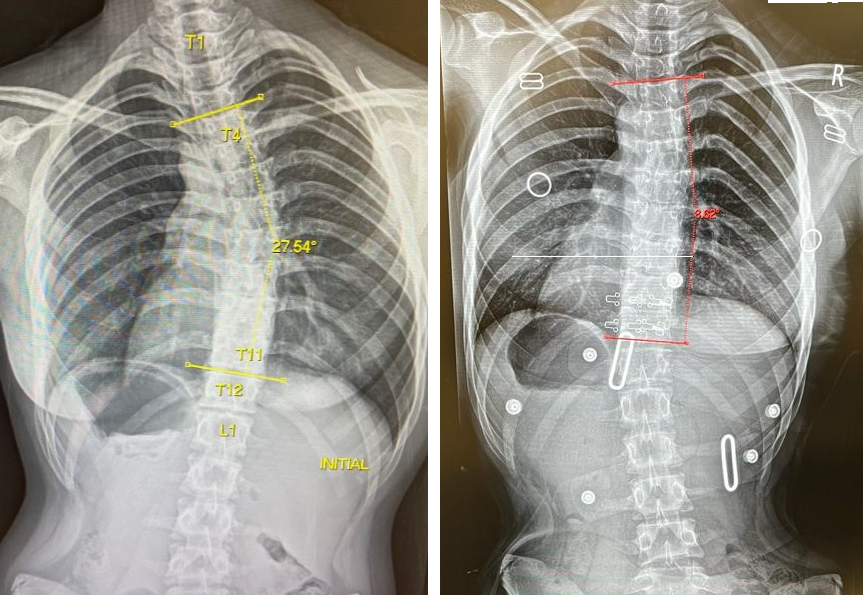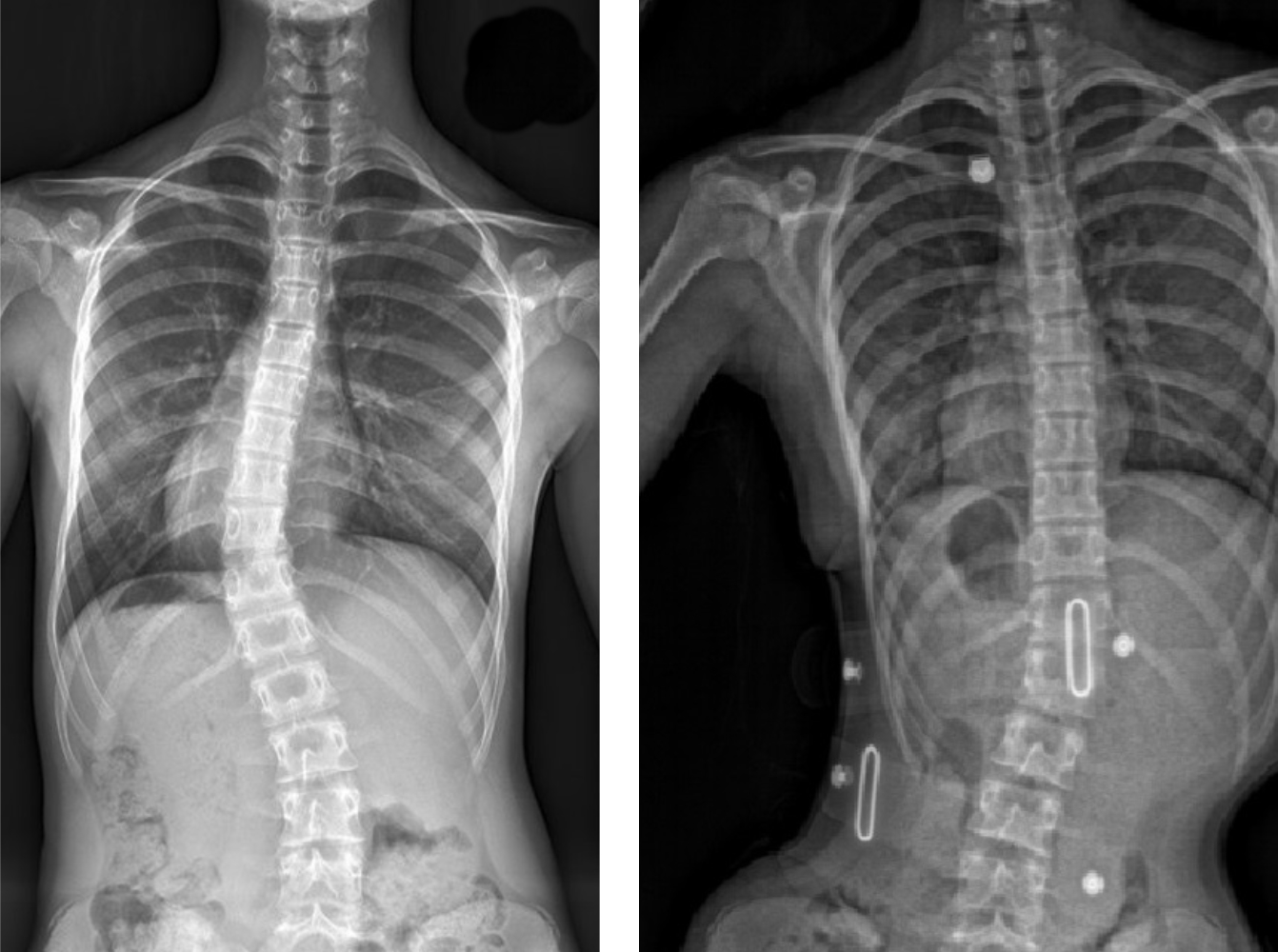Scoliosis is the medical term that describes the abnormal twisting and curvature of the spine. It occurs most often during the growth spurt just before puberty. It affects around three to four children in every 1,000 in the UK and is most typically seen in children between the ages of 10 and 15. It is also more common among females than males.
Since LOC opened its Scoliosis clinic in 2017, we have treated a broad age range of patients from 3-year-olds to 80-year-olds.
Even those with severe scoliosis, where the Cobb angle is in excess of 40 degrees, have responded well to the combination of bracing with the Cheneau-Gensingen brace and a physiotherapy programme that follows the principles of Schroth physiotherapy.

Classification of scoliosis curves

Before & After

Before & After

Before & After

Before & After

Before & After

Before & After

Before & After

Before & After

Before & After

Before & After
As of September 2022, these are some of the in-brace x-ray results from our LOC Scoliosis Brace

LOC is pioneering the non-surgical treatment of scoliosis through back bracing with the LOC Scoliosis Brace and specialist Schroth Treatment physiotherapy as spinal surgery is extremely invasive and can lead to complications.

The LOC Scoliosis Brace takes a three-dimensional approach to scoliosis treatment. This type of bracing is regarded by many scoliosis clinics around the world as the preferred alternative to surgery, since it has been proven to reduce Cobb angles and improve posture.

Our bespoke scoliosis treatment can be combined with a comprehensive physiotherapy programme that adheres to the principles of the world-renowned Schroth treatment.
Our treatment package price includes all reviews and on-site adjustments of the brace by our certified orthotists.

There may be cancellations or delays to your child’s spinal surgery for several reasons. At LOC, we are here to assist where possible. Using our corrective LOC Scoliosis Brace, we can halt the curve's progression, balance posture and reduce any back pain.

Our scoliosis treatment recommendations are based on the severity of the Cobb angle and the age of the patient. If the Cobb angle is over 25° it is likely that we will recommend a LOC Scoliosis Brace combined with Schroth physiotherapy. Our treatment is customised for all age groups, juvenile, adolescent and adult.

Kyphosis causes pain if excessive or if in the wrong place such as the lower back.
Our bespoke physiotherapy programme can improve muscle lengths & spinal extensor strength, reducing postural pain.
Scoliosis may first be noticed by a change in the appearance of a child’s back. Symptoms can include:
Each scoliosis curve is unique. The spine may curve to the left or right and it can happen in different parts of the spine. If it is in the chest area it is called ‘thoracic’ scoliosis, while if it is the lower part of the spine it is called ‘lumbar’ scoliosis. It is also possible to have two curves; this is called a double curvature and the spine may look like an ‘S’ shape from behind. It is further possible to have more compensatory curves at the top and bottom of the spine.

As scoliosis is a three-dimensional condition and the spine is always trying to compensate there are numerous potential curve variations. However, the most common curve is the right thoracic curve.
At the moment you may find it difficult to get a referral to your local hospital, we can provide clinical assessments and refer your child for any necessary back x-rays or scans required. These scans will help us determine the progression factor. This is the incidence of progression of untreated idiopathic scoliosis according to the formula by Lonstein and Carlson (see graph); this considers the severity of the curve and the skeletal maturity of the patient.
A patient’s treatment can involve one or all of these elements: observation, specialist scoliosis physiotherapy and bespoke back bracing. The correct prescription and combination of these elements will be determined by one of our team of specialist scoliosis clinicians. At the patient’s initial consultation, the clinician will look at posture, the exact nature of the curve and its flexibility and will also assess the pain associated with the condition. The skeletal maturity and age of the individual will also affect the recommended treatment plan, as described above.
Scoliosis can progress quickly when the skeleton is still growing or during hormonal changes so if you are concerned about your child please contact us.

References:
At the initial consultation, we will conduct a detailed clinical assessment to assess posture/leg length/progression factor of the curve/flexibility of the body and then discuss the most appropriate treatment. If you have already been diagnosed with scoliosis you will need to bring with you a recent X-ray of your spine. The existence of scoliosis is established by measuring the Cobb angle of the spinal curves. The Cobb angle was first described in 1948 by Dr John R Cobb, an American orthopaedic surgeon. A Cobb angle of 10° is regarded as the minimum angulation to define scoliosis.
We use a scoliometer to measure the angle of trunk rotation. This is a small non-invasive device that is placed over the spine while the patient being measured is in a forward bending position. As it provides a reading in degrees, it is important not to confuse the Cobb reading with a scoliometer reading. The scoliometer is a useful tool for monitoring our patients while reducing the need for x-rays.
Our scoliosis treatment recommendations will be based on the severity of the Cobb angle and the age of the patient. This allows us to calculate the risk of progression and determine the most appropriate conservative management for each patient. We also factor in the individual’s lifestyle and symptoms.

The criterion for treatment is based on the patient’s Cobb angle:
Victor the Robot, our new Computer Numerical Control milling machine, in action! Victor is noisy, but he’s transforming our ability to design and manufacture orthotic devices at our Kingston-upon-Thames clinic.
Manufactured by Rodin4D, Victor is capable of milling complex ergonomic shapes, meaning that we can now potentially assess a spinal orthotic patient, manufacture the orthosis and have it fitted, all in the space of a day. Victor can do everything we need to do for our patients, in-house and in the shortest time possible with no compromise on quality.

“It’s life-changing, my swimming coach has even remarked what a difference my treatment has made" Read how pectus bracing treatment helped to correct Aris' complex chest deformity, involving a combination of pectus excavatum, pectus carinatum and rib flaring.

Cerebral palsy patient Lucas sees significant improvement in his walking after only six months in his new custom Ankle Foot Orthoses (AFOs), designed by Professor Saeed Forghany in our Manchester clinic. Hear how a detailed gait analysis and bespoke AFOs significantly improved Lucas's gait and comfort.

Freddie’s positional plagiocephaly was treated successfully with the LOCBand Lite, going from 11mm to 2mm after four months in his helmet.

Adult club foot (talipes) patient Natasha says, "I cannot stress how amazing my AFOs are and how they have changed so much for me. The support they give me allows me to walk without crutches outside the house for the first time in over fifteen years."

Diagnosed with adolescent idiopathic scoliosis at 14 years old, Polly and mum Zoe looked to the LOC Scoliosis Brace to help her curve and avoid surgery at a later date.

LOC opens its first clinic in Northern Ireland, LOC Belfast, offer non-surgical orthotic treatment for scoliosis, pectus carinatum and pectus excavatum. Here, we will also be able to provide orthotic treatments for a range of adult and paediatric lower limb conditions including cerebral palsy, spina bifida, hypermobility, stroke, post-polio syndrome, and multiple sclerosis.

Mum Natalie shares her experience of having both her identical twins diagnosed with craniosynostosis. Ella and Nina had surgery at Great Ormond Street Hospital before going through cranial remoulding therapy at the London Orthotic Consultancy.

See how a thorough gait analysis and a correctly-fitted, bespoke Reciprocating Gait Orthosis (RGO) helped Ted, a spinal surgery and cancer survivor, improve his rehabilitation and mobility goals, getting him back on his feet again.